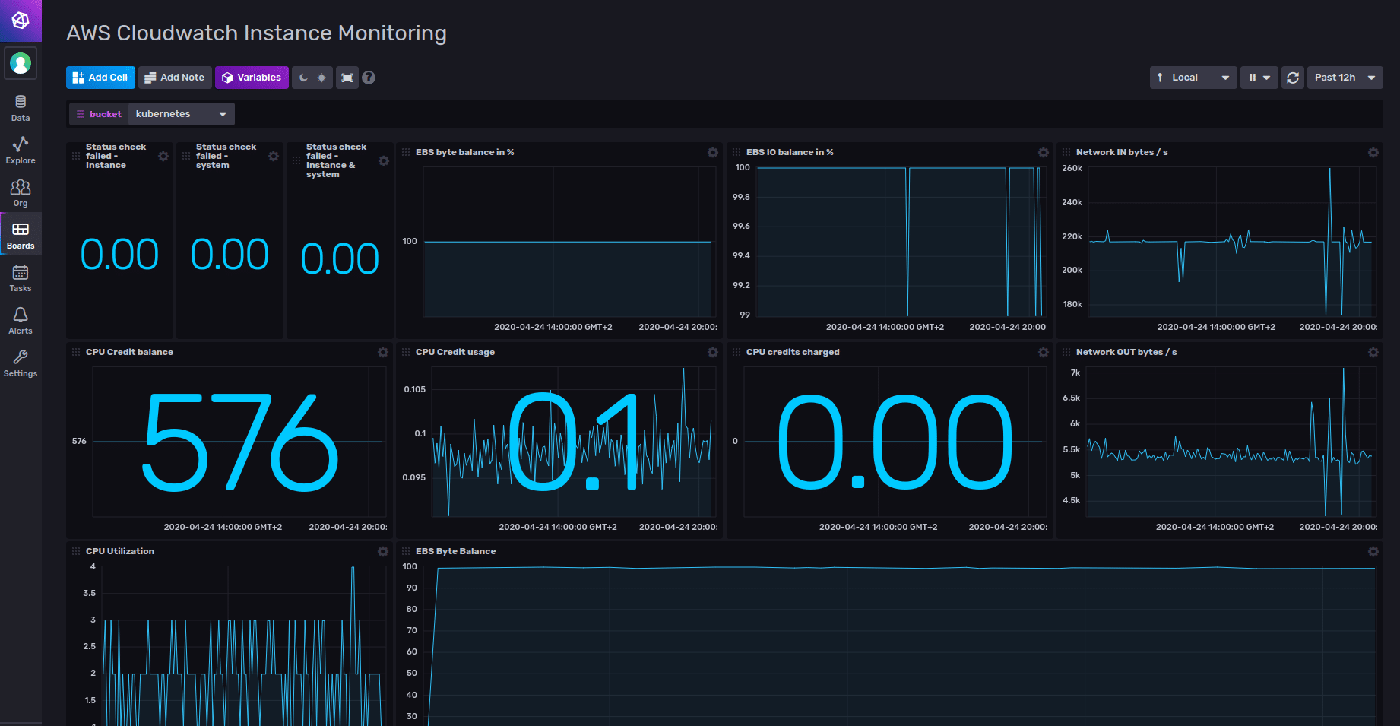InfluxData Updates Aim To Speed Delivery of Real-Time, Data-Driven Apps
InfluxData continues to enhance its time series database-as-a-service to let developers more easily tap into real-time data and metrics. IDN speaks with InfluxData vice president Tim Hall.
by Vance McCarthy
Tags: cloud, ETL, Flux, InfluxData, schema-less, scripting, time series database,

vice president of products

"One of the major advantages of InfluxDB is its ability to ingest as much time series data as possible. It's part of the design of a schema-less database."
 Modern Application Development for Digital Business Success
Modern Application Development for Digital Business Success2022
Time series platform provider InfluxData is adding new capabilities to its InfluxDB Cloud database-as-a-service to help developers build analytics, IoT, and cloud-native apps more easily.
The latest set of InfluxDB Cloud updates continue to expand the ability for developers to more easily capture a wide range of data and metrics, including real-time support, according to Tim Hall, vice president of products at InfluxData.
"One of the major advantages of InfluxDB is its ability to ingest as much time series data as possible. It's not just a perk. It's part of the design of a schema-less database," Hall told IDN.
"With these updates, InfluxDB can better help developers unlock the value of time-stamped data through a consistent, intuitive, easy-to-use experience. Developer happiness lies at the heart of our innovation strategy so teams can build real-time applications in any way they want,” Hall said.
Notable InfluxDB feature updates include:
Explicit Schema Option to let developers explicitly define the schema of a bucket within InfluxDB. This allows them to safeguard against unwanted changes to their apps.
API Invocable Scripts allow builders to make apps more intuitive by delivering predictive outcomes through triggered automated actions. These let developers build "parameterized" scripts in InfluxData's Flux open source scripting language.
InfluxDB Updates Fuel Data Access; Minimizes' Noisy Data'
Hall also acknowledged having access to high amounts of data can be a double-edged sword when it creates more noise than meaningful data.
"While we're announcing a new feature that can help with data filtering, the developers working with that data will still have decisions to make," Hall told IDN. That said, the issue of 'noisy data' is a very real one."
We asked Hall to share more detail on how the InfluxDB Cloud time series database service helps balance the need for more data while allowing developers to manage 'data-to-noise' issues.
The issue of 'noisy data' is a very real one
If there's data in InfluxDB that goes unused or misses the mark in terms of driving a particular business outcome or objective, then developers should get rid of it. InfluxDB already makes use of retention policies, so that noisy data will automatically age out over time. But we also recognize that relying on retention policy is a downstream solution and that developers may want to prevent some data from hitting their instance of InfluxDB.
Conversely, developers looking for an upstream solution can define the types of data you want to collect and develop a schema based on those. That's essentially what we've done with the new explicit schema option. Developers can configure an instance of InfluxDB to collect data based on a schema.
The trade-off is that this requires additional configuration from developers. They need to truly understand their use case and the shape of their data, but if that's the case, an explicit schema effectively functions as a filter for noisy data.
So, at the end of the day, technology plays a role, but people and processes retain some responsibility, too.
InfluxData Also Puts Flux Scripting Language in Focus
Aside from updates to InfluxDB Cloud, many other InfluxData's latest improvements focus on Flux, the standalone data scripting and query language that increases productivity and code reuse.
Flux is open source and optimized for ETL, monitoring, and alerting, with an inline planner and optimizer.

InfluxData revealed several new technologies to help builders can more easily write Flux queries: They include:
- InfluxDB Notebooks enhancements: These enable developers to set up an alert quickly, build a task, or write a Flux script so they can start application building without having to leave their browser.
- Auto-generated Flux queries: With these, developers can easily compose Flux queries to be included in client code and auto-generated into 10+ languages, allowing teams to check and test code as they collaborate quickly.
- Flux Visual Studio Code Extension: This extension offers a fast and easy way for developers to write Flux scripts, query InfluxDB, create Flux tasks, and manage buckets. The extension also provides syntax checking and contextual autocomplete for Flux queries.
- Flux additions to encourage "seamless" workflows. With these and other enhancements, Flux developers can drive business-centric results. One use case would be sending notifications and providing query support for apps including Alerta, WebEx Teams, and ServiceNow.
With so much energy and investment focused on Flux, we asked hall to share InfluxData's vision for Flux and how developers will benefit in the current version and into the future.
The development of Flux and its continued evolution is geared toward expediting what we call developer' Time to Awesome'.
We understand that not all developers use the same infrastructure, programming languages or development procedures. As developers ourselves, we get it. This is why we're building out Flux to meet developers where they are choosing to build apps – on their terms.
Although we introduced Flux as a functional language, it is new. Flux is very powerful in terms of its ability to analyze, transform, and query InfluxDB in a single pass, and it's up to InfluxData to reduce the friction of learning a new language. We need to provide resources to developers to educate, train, explain, provide examples, and illustrate both the simplicity and the power of Flux. This is an ongoing mission because new developers are coming to InfluxDB every day.
InfluxData's Flux To Expand Ecosystem for Data-Driven, Real-Time Apps
Interestingly, Hall noted that even as InfluxData deepens its focus on Flux language, the investment will expand support for multiple query languages – and even cut the need to hand code in certain use cases.
Meeting developers where they are also means supporting multiple query languages so developers can choose the right tool for them to do the job.
This strategy also keeps the barrier to entry low while allowing us space to advance Flux's capabilities, such as integrations with third party notification systems, analysis functions, time zone support, and steadily improving its performance at scale.
This type of interoperability should allow developers to opt-in to using Flux sooner, and by extension, reduce the necessity of writing code whenever possible. Flux provides a broad spectrum of usability, supporting very simple use cases while at the same time enabling extremely powerful use cases to co-exist within the same language.
It also facilitates querying data closer to the source. Currently, there are more than a dozen data sources (e.g., Snowflake, Microsoft SQL Server, AWS Athena, Google BigTable, BigQuery, etc.) where developers can create and execute a SQL statement within Flux and pull that relational data into context. That data can then be joined with query results from InfluxDB and presented in a single, unified view to an application, API, user, or other end point.
Finally, the Flux script reduces the amount of code developers would otherwise need to write to achieve the same results. Flux not only allows developers to take advantage of all InfluxDB's features, but it also extends that usability to other sources. InfluxData is willing to add support for additional query languages in the future if doing so makes sense for Flux, InfluxDB, and our developer community.
One analyst noted the benefits of InfluxData's latest upgrade, especially those that provide a "consistent application building experience" for cloud, on-premise or both, according to KellyAnn Fitzpatrick, a senior industry analyst at RedMonk. "InfluxData's new capabilities aim to eliminate many of the barriers to application building by creating a more seamless, developer-friendly and productive experience for working with time series data."
InfluxData customers also welcomed the latest updates that support new capabilities for developers working on data-driven apps.
Martin Moucka, a principal network engineer at Red Hat commented, "These [InfluxDB platform] new capabilities will allow us to achieve even greater network visibility and real-time monitoring, and improve the overall performance of our team. InfluxData continues to innovate with the developer in mind so we can build powerful time series data applications," Moucka said in a statement. "The InfluxDB platform has made us a more data-driven and proactive team."
Angelo Fausti, a software engineer at the Vera C. Rubin Observatory, said, "We're recording 500 petabytes of image data and measuring the properties of 37 billion stars and galaxies. InfluxDB sits at the center of our technology strategy with its flexible and collaborative platform, and these new features will help us unlock even more insights from our data."
Related:
- InfluxData's Latest Updates Optimize Time Series Data for Better Performance, Scale and Management
- Actian Zen 16.0 Update Simplifies Delivery and Boosts Performance of Edge, IoT Apps
- Virtana Infrastructure Performance Management Adds AI-driven Capacity Planning
- e2open’s Supply Chain SaaS Updates Help Firms Reduce Operational Risks with Deeper Visibility
- Report: Endor Labs Identifies 2023 Operational, Security Risks To Open Source
All rights reserved © 2025 Enterprise Integration News, Inc.


